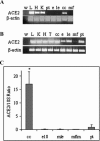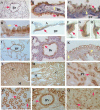Angiotensin converting enzyme 2 is primarily epithelial and is developmentally regulated in the mouse lung
- PMID: 17340620
- PMCID: PMC7166549
- DOI: 10.1002/jcb.21248
Angiotensin converting enzyme 2 is primarily epithelial and is developmentally regulated in the mouse lung
Abstract
Angiotensin converting enzyme (ACE) 2 is a carboxypeptidase that shares 42% amino acid homology with ACE. Little is known about the regulation or pattern of expression of ACE2 in the mouse lung, including its definitive cellular distribution or developmental changes. Based on Northern blot and RT-PCR data, we report two distinct transcripts of ACE2 in the mouse lung and kidney and describe a 5' exon 1a previously unidentified in the mouse. Western blots show multiple isoforms of ACE2, with predominance of a 75-80 kDa protein in the mouse lung versus a 120 kDa form in the mouse kidney. Immunohistochemistry localizes ACE2 protein to Clara cells, type II cells, and endothelium and smooth muscle of small and medium vessels in the mouse lung. ACE2 mRNA levels peak at embryonic day 18.5 in the mouse lung, and immunostaining demonstrates protein primarily in the bronchiolar epithelium at that developmental time point. In murine cell lines ACE2 is strongly expressed in the Clara cell line mtCC, as opposed to the low mRNA expression detected in E10 (type I-like alveolar epithelial cell line), MLE-15 (type II alveolar epithelial cell line), MFLM-4 (fetal pulmonary vasculature cell line), and BUMPT-7 (renal proximal tubule cell line). In summary, murine pulmonary ACE2 appears to be primarily epithelial, is developmentally regulated, and has two transcripts that include a previously undescribed exon.
(c) 2007 Wiley-Liss, Inc.
Figures






Similar articles
-
Ontogeny of angiotensin-converting enzyme 2.Pediatr Res. 2012 Jan;71(1):13-9. doi: 10.1038/pr.2011.7. Pediatr Res. 2012. PMID: 22289845
-
Collectrin, a collecting duct-specific transmembrane glycoprotein, is a novel homolog of ACE2 and is developmentally regulated in embryonic kidneys.J Biol Chem. 2001 May 18;276(20):17132-9. doi: 10.1074/jbc.M006723200. Epub 2001 Jan 31. J Biol Chem. 2001. PMID: 11278314
-
Angiotensin-converting enzyme 2 (ACE2), but not ACE, is preferentially localized to the apical surface of polarized kidney cells.J Biol Chem. 2005 Nov 25;280(47):39353-62. doi: 10.1074/jbc.M508914200. Epub 2005 Sep 15. J Biol Chem. 2005. PMID: 16166094
-
Developmental regulation of angiotensin converting enzyme and angiotensin type 1 receptor in the rat pulmonary circulation.Am J Respir Cell Mol Biol. 1996 Jun;14(6):526-37. doi: 10.1165/ajrcmb.14.6.8652181. Am J Respir Cell Mol Biol. 1996. PMID: 8652181
-
Emerging markers in cardiovascular disease: where does angiotensin-converting enzyme 2 fit in?Clin Exp Pharmacol Physiol. 2013 Aug;40(8):551-9. doi: 10.1111/1440-1681.12069. Clin Exp Pharmacol Physiol. 2013. PMID: 23432153 Review.
Cited by
-
Hyperoxia downregulates angiotensin-converting enzyme-2 in human fetal lung fibroblasts.Pediatr Res. 2015 May;77(5):656-62. doi: 10.1038/pr.2015.27. Epub 2015 Feb 9. Pediatr Res. 2015. PMID: 25665060 Free PMC article.
-
Good or bad: Application of RAAS inhibitors in COVID-19 patients with cardiovascular comorbidities.Pharmacol Ther. 2020 Nov;215:107628. doi: 10.1016/j.pharmthera.2020.107628. Epub 2020 Jul 9. Pharmacol Ther. 2020. PMID: 32653530 Free PMC article. Review.
-
Trilogy of ACE2: a peptidase in the renin-angiotensin system, a SARS receptor, and a partner for amino acid transporters.Pharmacol Ther. 2010 Oct;128(1):119-28. doi: 10.1016/j.pharmthera.2010.06.003. Epub 2010 Jul 3. Pharmacol Ther. 2010. PMID: 20599443 Free PMC article. Review.
-
Characterization of Two Heterogeneous Lethal Mouse-Adapted SARS-CoV-2 Variants Recapitulating Representative Aspects of Human COVID-19.Front Immunol. 2022 Feb 7;13:821664. doi: 10.3389/fimmu.2022.821664. eCollection 2022. Front Immunol. 2022. PMID: 35197985 Free PMC article.
-
SARS-CoV-2 COVID-19 susceptibility and lung inflammatory storm by smoking and vaping.J Inflamm (Lond). 2020 Jun 10;17:21. doi: 10.1186/s12950-020-00250-8. eCollection 2020. J Inflamm (Lond). 2020. PMID: 32528233 Free PMC article. Review.
References
-
- Coffinier C, Barra J, Babinet C, Yaniv M. 1999. Expression of the vHNF1/HNF1beta homeoprotein gene during mouse organogenesis. Mech Dev 89: 211–213. - PubMed
-
- Crackower MA, Sarao R, Oudit GY, Yagil C, Kozieradzki I, Scanga SE, Oliveira‐dos‐Santos AJ, da Costa J, Zhang L, Pei Y, Scholey J, Ferrario CM, Manoukian AS, Chappell MC, Backx PH, Yagil Y, Penninger JM. 2002. Angiotensin‐converting enzyme 2 is an essential regulator of heart function. Nature 417: 822–828. - PubMed
Publication types
MeSH terms
Substances
Grants and funding
LinkOut - more resources
Full Text Sources
Molecular Biology Databases
Miscellaneous

